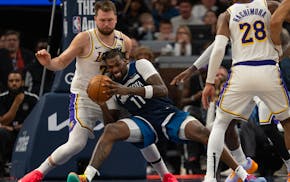Michigan State coach Tom Izzo opened his postgame news conference Wednesday talking about how well the Gophers had been defensively this season. But the game played out much differently.
The Gophers gave up their most points ever in a loss to Michigan State, falling 90-72 to a Spartans squad that entered the night as the worst three-point shooting team in Division I.
Izzo thought fast-break points (27) were the biggest factor in how well his team played offensively to shoot 52.7% from the field. But Michigan State also went 11-for-22 from three-point range, which was surprising since it was shooting 22.4% from three this year.
"This is a team in Minnesota that's been guarding very well," Izzo said. "We hadn't been shooting real well, so it was a good game for us to come out of it. I thought our running game really helped us. We got some open looks in our running game. Looked more like the old us."
Unfortunately for coach Ben Johnson, his Gophers played defense like they had in past years when that wasn't a strength. They seemed to be going through a defensive identity crisis going into Monday's second Big Ten game at Indiana.
"What's our response going to be from here on out?" Johnson said. "We know the standard of what it takes to compete and to give yourself a chance. So we've got to a good job of holding ourselves to that standard."
The Gophers were a top-50 team nationally in defensive efficiency even after back-to-back losses against Wichita State and Wake Forest in Orlando, but the last two games have ruined their numbers.
The Gophers now rank 86th in defensive efficiency by KenPom and 87th by Bart Torvik. This decline actually started in Sunday's 79-62 win against Bethune-Cookman.
In the second half, the Gophers allowed Bethune-Cookman to shoot 50% from the field, including 7-for-13 from three. Michigan State shot 55.6% overall in the second half Wednesday, including 7-for-10 from deep.
Johnson thought maybe fatigue was a factor since the Gophers had four games in seven days.
"I think we have to find a way to push through," he said. "I think when guys get tired, you could be in the right spot, but if you're a second late or if you don't have a hand up or if that second effort's not there, that's what really hurts you. … I thought for whatever reason we felt worn down in that second half. Didn't have the juice and energy to get going."
One thing that got better in the second half was Minnesota's rebounding. Michigan State won the battle of the boards 24-8 in the first half, including nine offensive rebounds. That flipped with the Gophers having a 19-15 advantage in the second half.
Against two major conference foes this season, the Gophers were minus-13.5 in rebounding margin vs. Wake Forest and Michigan State and gave up 25 offensive boards combined. That makes it even harder to get defensive stops.
Opponents in the Gophers' four losses this season have also outscored them by eight on average in points in the paint and averaged 36.5 points in the paint in those games. In the last two games, Michigan State and Bethune-Cookman also combined to shoot 21-for-42 from beyond the arc.
The Gophers are still fifth among Big Ten teams in points allowed per game (62.0), but they've dropped to 16th in three-point shooting defense (33.3%) and 13th in field-goal defense (41.8%).
It will be interesting to see how the U's defensive numbers hold up moving forward, especially on the road Monday in Bloomington, Ind. The Hoosiers are third in the Big Ten in field-goal shooting (49.9%) and fifth in three-point shooting (37%).
"We got to lean on our staple, which is defense," Gophers leading scorer Dawson Garcia said Wednesday. "We didn't do that at all."

Scoggins: Redick's no-sub second half looked desperate, appears damaging

Edwards scores 43 as Wolves gain control of series with Lakers

Souhan: Timberwolves star works in a shove while pushing Lakers to a precipice
Coach and athletic director who put Hamline on the rise dies at 100

